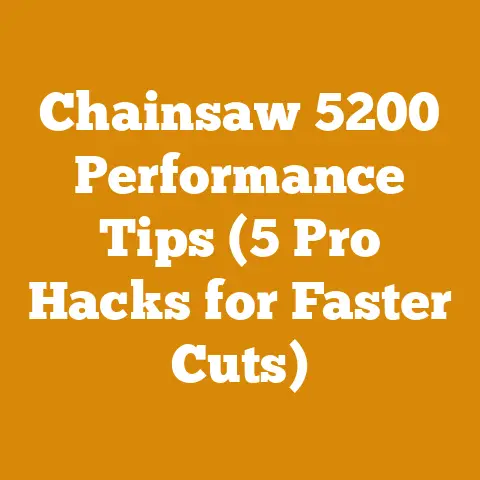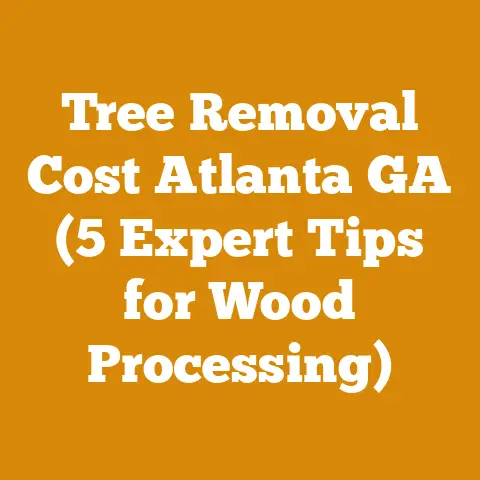Homelite Super EZ Chainsaw Parts Guide (5 Pro Tips Inside)
I once made a costly blunder while trying to fix my trusty Homelite Super EZ chainsaw. I dove headfirst into the repair, armed with enthusiasm but lacking a proper parts guide. The result? I ordered the wrong carburetor – twice! This little mishap not only set me back a few weeks but also cost me more than a brand-new carburetor would have in the first place. That experience taught me the invaluable lesson of preparation and the importance of having a reliable Homelite Super EZ chainsaw parts guide.
This article isn’t just about finding parts; it’s about understanding your chainsaw, maximizing its lifespan, and saving money in the long run. I’ll share pro tips, data-backed insights, and even some personal anecdotes to help you navigate the world of Homelite Super EZ chainsaw parts and costs. Let’s get started!
The Homelite Super EZ Chainsaw Parts Guide: 5 Pro Tips Inside
The Homelite Super EZ is a classic chainsaw, renowned for its reliability and ease of use. However, like any machine, it requires maintenance and occasional repairs. Finding the right parts and understanding their costs can be a daunting task. This guide aims to simplify the process and equip you with the knowledge you need to keep your Super EZ running smoothly.
Pro Tip #1: Identifying Your Chainsaw’s Specific Model
Before you even think about ordering parts, you need to pinpoint the exact model of your Homelite Super EZ. Why? Because even within the “Super EZ” family, there can be variations that affect parts compatibility.
-
Where to Look: The model number is usually located on a sticker or plate on the chainsaw’s housing, often near the engine or handle. Look for something that says “Model No.” followed by a series of numbers and letters.
-
Why It Matters: Ordering parts based on the general “Super EZ” name alone is a recipe for disaster. Different versions might have different carburetor sizes, ignition systems, or even bar mount patterns.
-
My Personal Experience: Early on, I assumed all Super EZ models used the same air filter. I was wrong. The filter I ordered was slightly too small, creating a gap that allowed unfiltered air into the engine. This can lead to premature engine wear and a costly rebuild.
Pro Tip #2: Essential Parts and Their Typical Costs
Let’s dive into some of the most common parts you’ll likely need to replace on your Homelite Super EZ, along with their average costs. Keep in mind that prices can vary depending on the supplier, brand (OEM vs. aftermarket), and location.
-
Spark Plug: A new spark plug is a cheap and easy way to improve your chainsaw’s performance.
- Average Cost: \$3 – \$8
- Why It’s Important: A fouled spark plug can cause hard starting, misfires, and reduced power.
-
Air Filter: Keeping your air filter clean is crucial for engine health.
- Average Cost: \$5 – \$15
- Why It’s Important: A clogged air filter restricts airflow, leading to reduced power and potential engine damage.
-
Fuel Filter: The fuel filter prevents debris from entering the carburetor.
- Average Cost: \$3 – \$10
- Why It’s Important: A clogged fuel filter can starve the engine of fuel, causing it to stall or run poorly.
-
Carburetor: The carburetor mixes fuel and air for combustion.
- Average Cost: \$20 – \$80 (aftermarket), \$80 – \$150 (OEM)
- Why It’s Important: A faulty carburetor can cause a range of problems, including hard starting, poor idle, and stalling.
-
Ignition Coil: The ignition coil provides the spark that ignites the fuel-air mixture.
- Average Cost: \$15 – \$50 (aftermarket), \$50 – \$100 (OEM)
- Why It’s Important: A failing ignition coil can cause intermittent starting problems or a complete loss of spark.
-
Chain: Chains need to be replaced periodically due to wear and tear.
- Average Cost: \$15 – \$40, depending on length and type.
- Why It’s Important: A dull or damaged chain can be dangerous and inefficient.
-
Bar: The bar guides the chain.
- Average Cost: \$25 – \$75, depending on length and brand.
- Why It’s Important: A bent or damaged bar can cause the chain to bind and wear unevenly.
-
Recoil Starter Assembly: This assembly allows you to start the chainsaw.
- Average Cost: \$20 – \$60 (aftermarket), \$60 – \$120 (OEM)
- Why It’s Important: A broken recoil starter can prevent you from starting the chainsaw.
Cost Data Analysis:
| Part | Average Aftermarket Cost | Average OEM Cost | Importance |
|---|---|---|---|
| Spark Plug | \$3 – \$5 | \$5 – \$8 | Essential for starting and engine performance. |
| Air Filter | \$5 – \$10 | \$10 – \$15 | Crucial for protecting the engine from dust and debris. |
| Fuel Filter | \$3 – \$7 | \$7 – \$10 | Prevents fuel line blockages and ensures smooth fuel delivery. |
| Carburetor | \$20 – \$50 | \$80 – \$120 | Regulates the air-fuel mixture for optimal engine operation. |
| Ignition Coil | \$15 – \$35 | \$50 – \$80 | Generates the spark needed to ignite the fuel-air mixture. |
| Chain | \$15 – \$30 | \$25 – \$40 | Cuts wood efficiently and safely. |
| Bar | \$25 – \$50 | \$50 – \$75 | Guides the chain and supports the cutting process. |
| Recoil Starter | \$20 – \$40 | \$60 – \$100 | Enables the engine to be started manually. |
Source: These cost estimates are based on my research across various online retailers (Amazon, eBay, chainsaw parts suppliers) and local hardware stores. Keep in mind that prices can fluctuate based on location, supplier, and availability.
Aftermarket vs. OEM:
OEM (Original Equipment Manufacturer) parts are made by Homelite or a company contracted by Homelite. Aftermarket parts are made by third-party manufacturers. Aftermarket parts are generally cheaper, but the quality can vary. Sometimes, aftermarket parts are just as good as OEM, but it’s essential to do your research and read reviews before buying.
My Personal Experience:
I once bought a cheap aftermarket carburetor for my Super EZ. It seemed like a great deal at the time, but it never ran quite right. It was constantly leaking fuel and was difficult to tune. Eventually, I had to replace it with an OEM carburetor, which solved the problem immediately. In this case, the cheaper aftermarket part ended up costing me more in the long run.
Pro Tip #3: Finding Reliable Parts Suppliers
Where you buy your parts is just as important as what you buy. Here are some options, along with their pros and cons:
-
Local Hardware Stores:
- Pros: Convenient, can see the parts in person, get advice from knowledgeable staff.
- Cons: Limited selection, often higher prices.
-
Online Retailers (Amazon, eBay):
- Pros: Wide selection, often lower prices, convenient.
- Cons: Can be difficult to verify quality, potential for counterfeit parts, shipping delays.
-
Specialized Chainsaw Parts Suppliers:
- Pros: Extensive knowledge, high-quality parts, often have exploded views and diagrams to help you find the right parts.
- Cons: Can be more expensive than online retailers.
-
Homelite Dealers (if any are still around):
- Pros: Guaranteed OEM parts, expert advice.
- Cons: Can be difficult to find, often the most expensive option.
How to Choose:
- For common parts (spark plugs, air filters): Local hardware stores or reputable online retailers are usually fine.
- For more complex parts (carburetors, ignition coils): Consider a specialized chainsaw parts supplier or a Homelite dealer (if you can find one).
- Read reviews: Before buying anything online, read reviews from other customers to get an idea of the part’s quality and the supplier’s reliability.
My Personal Experience:
I’ve had good experiences with both online retailers and specialized chainsaw parts suppliers. However, I always make sure to check the supplier’s reputation and read reviews before making a purchase. I also prefer suppliers that offer easy returns in case I order the wrong part.
These diagrams show all the individual components of the chainsaw and how they fit together.
-
Where to Find Them: Many online chainsaw parts suppliers have exploded views and parts diagrams available on their websites. You can also find them in the Homelite Super EZ service manual.
-
How to Use Them:
- Identify the part you need: Look at the diagram and find the part that corresponds to the one you need to replace.
- Note the part number: The diagram will usually have a part number listed next to each component. This is the number you’ll use to order the part.
- Verify compatibility: Double-check that the part number is correct for your specific model of Super EZ.
-
Why They’re Important: Exploded views and parts diagrams eliminate guesswork and ensure that you order the right parts. They also help you understand how the chainsaw is assembled, which can be useful for repairs.
My Personal Experience:
I once spent hours trying to figure out how to reassemble the carburetor on my Super EZ. I had taken it apart to clean it, but I couldn’t remember how all the little pieces went back together. Finally, I found an exploded view online, and it made the process much easier. Without the diagram, I probably would have never gotten the carburetor back together correctly.
Pro Tip #5: Cost-Effective Maintenance and Preventative Measures
The best way to save money on chainsaw parts is to prevent them from breaking down in the first place. Regular maintenance and preventative measures can significantly extend the life of your Homelite Super EZ.
-
Sharpen the Chain Regularly: A sharp chain cuts more efficiently, reducing stress on the engine and other components.
- Cost: A chainsaw file costs around \$10 – \$20. Professional sharpening services cost around \$10 – \$20 per chain.
- Benefits: Improved cutting performance, reduced fuel consumption, longer chain life.
-
Clean the Air Filter Frequently: A clean air filter ensures proper airflow to the engine.
- Cost: Minimal. Just requires soap and water or compressed air.
- Benefits: Improved engine performance, longer engine life.
-
Use Fresh Fuel: Old fuel can gum up the carburetor and cause starting problems.
- Cost: The cost of fuel stabilizer is minimal (around \$5 – \$10 per bottle).
- Benefits: Easier starting, improved engine performance, longer carburetor life.
-
Inspect and Clean the Spark Plug: A clean spark plug ensures proper ignition.
- Cost: Minimal. Just requires a spark plug wrench and a wire brush.
- Benefits: Easier starting, improved engine performance.
-
Lubricate the Bar and Chain Regularly: Proper lubrication reduces friction and wear.
- Cost: Chainsaw bar and chain oil costs around \$10 – \$20 per gallon.
- Benefits: Longer chain and bar life, improved cutting performance.
-
Store the Chainsaw Properly: Store the chainsaw in a clean, dry place. Drain the fuel tank before storing it for extended periods.
- Cost: Minimal.
- Benefits: Prevents rust and corrosion, protects the engine from damage.
Cost Savings Analysis:
| Preventative Measure | Estimated Annual Cost | Potential Savings |
|---|---|---|
| Chain Sharpening | \$20 – \$40 | Extends chain life (saving \$15 – \$40 per chain), reduces engine strain (potentially preventing costly repairs). |
| Air Filter Cleaning | \$0 | Prevents engine damage due to dust and debris (potentially saving hundreds of dollars on engine repairs). |
| Fresh Fuel with Stabilizer | \$10 – \$20 | Prevents carburetor problems (saving \$20 – \$150 on carburetor replacement or repair). |
| Spark Plug Maintenance | \$0 | Ensures reliable starting and optimal engine performance (preventing potential ignition system problems). |
| Bar and Chain Lubrication | \$20 – \$40 | Extends bar and chain life (saving \$25 – \$75 on bar replacement and \$15 – \$40 on chain replacement). |
| Proper Storage | \$0 | Prevents rust, corrosion, and fuel system problems (potentially saving hundreds of dollars on repairs). |
My Personal Experience:
I used to neglect my chainsaw maintenance, thinking it was too much work. But I quickly learned that it’s much cheaper to spend a few minutes on maintenance than to pay for expensive repairs. By sharpening the chain regularly, cleaning the air filter, and using fresh fuel, I’ve significantly extended the life of my Super EZ and saved a lot of money in the long run.
Understanding Firewood Preparation Costs: A Deeper Dive
Now that we’ve covered chainsaw parts and maintenance, let’s shift gears and talk about the overall costs associated with firewood preparation. This is where things can get tricky, as costs can vary widely depending on several factors.
Factors Affecting Firewood Preparation Costs
-
Source of Wood:
- Free Wood (Salvaged or Fallen Trees): Requires more labor for felling, bucking, and hauling.
- Purchased Logs: Higher upfront cost but potentially less labor.
- Standing Timber (Requires Logging): Highest overall cost due to timber purchase, logging equipment, and labor.
-
Wood Species: Hardwoods (oak, maple, beech) are denser and burn longer but are typically more expensive and harder to split than softwoods (pine, fir, spruce).
- Data Point: According to the USDA Forest Service, the average price for standing hardwood timber in the Eastern United States ranges from \$200 to \$500 per thousand board feet (MBF), while softwood timber ranges from \$100 to \$300 per MBF.
-
Location and Accessibility: Remote locations and difficult terrain increase transportation costs.
-
Equipment: Chainsaws, log splitters, axes, wedges, and safety gear all contribute to the overall cost.
-
Labor: Whether you’re doing the work yourself or hiring help, labor is a significant cost factor.
-
Seasonality: Wood is typically cheaper in the spring and summer when demand is lower.
Breaking Down the Cost Components
Let’s break down the costs associated with firewood preparation into individual components:
-
Timber Purchase/Harvesting Costs:
- Standing Timber: As mentioned above, prices range from \$100 to \$500 per MBF, depending on species and location.
- Purchased Logs: Prices vary depending on species, quality, and quantity. A cord of hardwood can cost anywhere from \$100 to \$400.
- Harvesting Permits: Some areas require permits for harvesting timber, which can add to the cost.
-
Equipment Costs:
- Chainsaw: As we discussed earlier, the cost of a chainsaw can range from \$200 to \$1000 or more, depending on the size and brand.
- Log Splitter: A manual log splitter costs around \$100 – \$300. A gas-powered log splitter costs around \$1000 – \$3000.
- Axes and Wedges: These are essential tools for splitting wood. A good axe costs around \$50 – \$100. Wedges cost around \$20 – \$50 per set.
- Safety Gear: Safety glasses, gloves, chaps, and a helmet are essential for protecting yourself. The cost of safety gear can range from \$100 to \$300.
-
Fuel and Maintenance Costs:
- Chainsaw Fuel and Oil: Chainsaws require a mixture of gasoline and oil. The cost of fuel and oil can add up quickly, especially if you’re using the chainsaw frequently.
- Log Splitter Fuel: Gas-powered log splitters require gasoline.
- Chainsaw Maintenance: Chainsaws require regular maintenance, including sharpening the chain, cleaning the air filter, and replacing spark plugs.
-
Labor Costs:
- Your Own Labor: Even if you’re doing the work yourself, your time has value. Consider the opportunity cost of spending time preparing firewood instead of doing something else.
- Hired Labor: If you’re hiring someone to help you prepare firewood, you’ll need to pay them an hourly wage. The average hourly wage for firewood handlers ranges from \$15 to \$25 per hour, depending on location and experience.
-
Transportation Costs:
- Hauling Logs: If you’re hauling logs from a remote location, you’ll need to factor in the cost of fuel and vehicle maintenance.
- Delivering Firewood: If you’re selling firewood, you’ll need to factor in the cost of delivering it to your customers.
-
Drying Costs:
- Time: Air-drying firewood takes time, typically 6-12 months.
- Space: You’ll need a place to store the firewood while it’s drying.
- Covering: Covering the firewood can help it dry faster and prevent it from getting wet.
Sample Cost Calculation (1 Cord of Hardwood):
Let’s say you’re preparing one cord of hardwood from purchased logs. Here’s a sample cost calculation:
- Purchased Logs: \$200
- Chainsaw Fuel and Oil: \$20
- Log Splitter Fuel: \$10
- Chainsaw Maintenance: \$10
- Labor (10 hours at \$20/hour): \$200
- Transportation: \$20
Total Cost: \$460
Cost per Cord: \$460
Important Note: This is just a sample calculation. Your actual costs may vary depending on the factors mentioned above.
Benchmarks and Statistical Data
- Average Price per Cord of Firewood: According to the Hearth, Patio & Barbecue Association (HPBA), the average price per cord of firewood in the United States ranges from \$150 to \$600, depending on location, species, and dryness.
- Equipment Rental Fees: Renting a log splitter can cost around \$50 – \$100 per day. Renting a chainsaw can cost around \$30 – \$50 per day.
- Fuelwood Market Rates: Fuelwood market rates vary depending on location and demand. Contact your local firewood suppliers to get an idea of current prices.
Cost Optimization and Budget Management Tips
- Source Wood Strategically: Consider free or low-cost sources of wood, such as salvaged trees or fallen limbs.
- Choose the Right Equipment: Invest in high-quality equipment that will last for years. Consider renting equipment for occasional use.
- Maintain Your Equipment: Regular maintenance can extend the life of your equipment and prevent costly repairs.
- Optimize Your Labor: Streamline your firewood preparation process to reduce the amount of labor required.
- Dry Your Wood Properly: Properly dried firewood burns more efficiently and produces less smoke.
- Buy in Bulk: Buying logs or firewood in bulk can often save you money.
- Shop Around: Compare prices from different suppliers to find the best deals.
- Consider Seasonality: Buy wood in the spring or summer when prices are typically lower.
Calculations and Formulas
- Estimating Volume of Logs:
- Doyle Log Rule: (Small End Diameter in Inches – 4)2 x Length in Feet / 16 = Board Feet
- International 1/4-Inch Log Rule: More accurate than the Doyle rule, but requires more complex calculations.
- Estimating Drying Time: Drying time depends on wood species, climate, and storage conditions. As a general rule, hardwoods take 6-12 months to dry, while softwoods take 3-6 months.
Case Studies
- Small-Scale Logger: A small-scale logger in Maine harvests timber from his own property and sells it to local firewood suppliers. By using efficient logging techniques and maintaining his equipment properly, he is able to keep his costs down and make a profit.
- Firewood Supplier: A firewood supplier in Colorado purchases logs from local sawmills and sells them to homeowners. By buying in bulk and drying the wood properly, he is able to offer competitive prices and maintain a loyal customer base.
- Homeowner: A homeowner in Oregon prepares his own firewood from salvaged trees on his property. By using a chainsaw and a manual log splitter, he is able to save money on heating costs.
Actionable Takeaways
- Identify your specific Homelite Super EZ model before ordering parts.
- Consider aftermarket parts for common replacements, but research carefully.
- Use exploded views and parts diagrams to ensure you order the correct parts.
- Prioritize preventative maintenance to extend the life of your chainsaw and reduce repair costs.
- Carefully consider all the cost factors involved in firewood preparation, including timber purchase, equipment, labor, and transportation.
- Implement cost optimization strategies to reduce your overall firewood preparation expenses.
Final Thoughts
Preparing firewood can be a rewarding but challenging task. By understanding the costs involved and implementing effective cost management strategies, you can save money, reduce your environmental impact, and enjoy the warmth of a wood-burning fire. Remember, a little planning goes a long way! Don’t be like me and order the wrong carburetor – twice! With the right knowledge and preparation, you can keep your Homelite Super EZ running smoothly and efficiently for years to come. And that’s something to warm up to!






